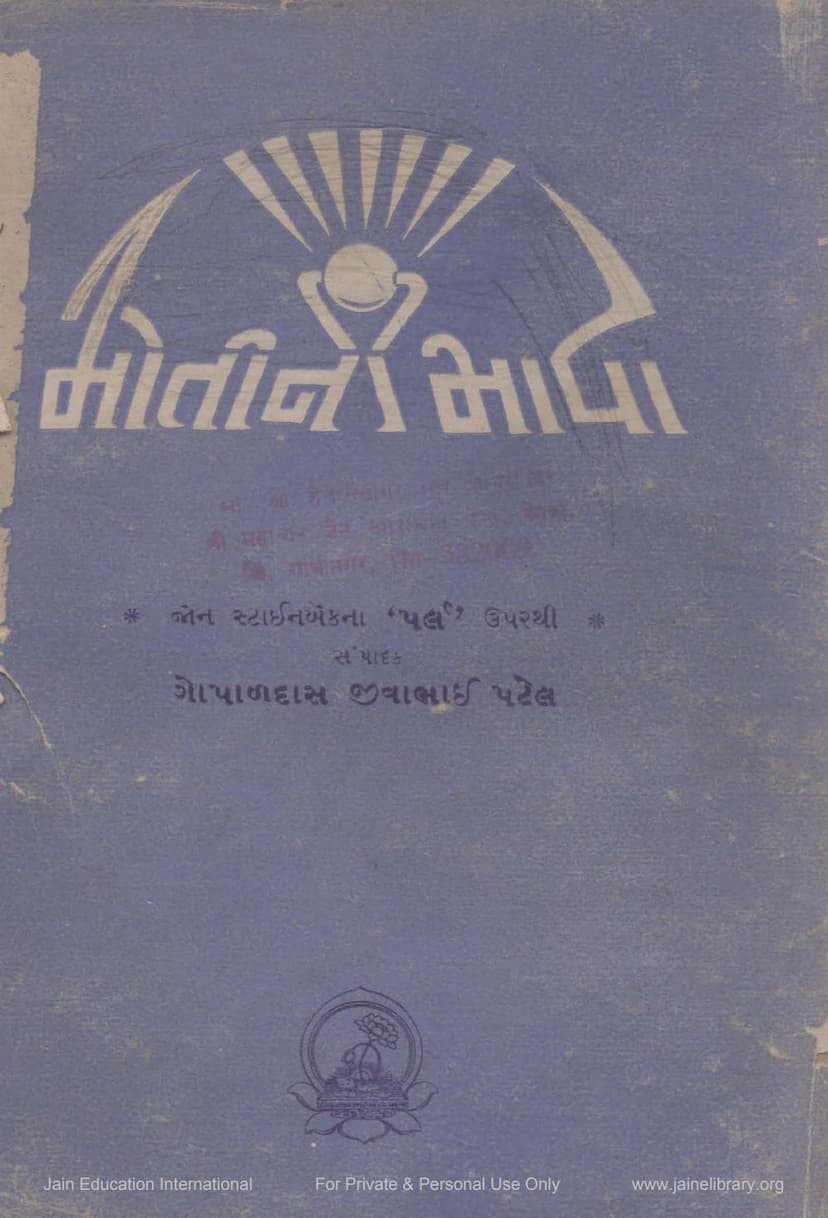Motini Maya
Added to library: September 2, 2025

Summary
Here's a comprehensive summary of the Jain text "Motini Maya" by Gopaldas Jivabhai Patel, based on the provided pages:
Book Title: Motini Maya (The Illusion of Pearls) Author: Gopaldas Jivabhai Patel Publisher: Parivar Prakashan Sahakari Mandir, Ahmedabad Original Source: Adapted from John Steinbeck's "The Pearl" Publication Year: 1963 (First Edition)
Overview:
"Motini Maya" is a Gujarati translation, or more accurately, an adaptation, of John Steinbeck's famous novella "The Pearl." The book is published by Parivar Prakashan Sahakari Mandir, Ahmedabad, and edited by Gopaldas Jivabhai Patel. The story is presented as a folk tale from the indigenous people of Mexico, specifically drawing parallels to the Mayan civilization. It explores the themes of greed, desire, societal corruption, and the destructive power of materialism, all within the context of a pearl's discovery.
Key Themes and Narrative Arc:
-
The Simple Life of the Kino Tribe: The story begins by introducing the Kino tribe, who live a simple, peaceful life in harmony with nature in their thatched huts. Their lives are characterized by communal living, a deep connection to their traditions, and the use of songs (stotras) to express various aspects of life. Kino, his wife Juana, and their infant son Coyotito are depicted in their humble but contented existence.
-
The Arrival of the Europeans and Cultural Disruption: The narrative highlights the arrival of Europeans (described as "Gorā" or white people) who disrupt the indigenous way of life. They bring with them religion, commerce, doctors, and a new social order that begins to encroach upon the natural rhythms of the Kino tribe. The story implicitly criticizes the exploitative nature of this colonial presence.
-
The Discovery of the Great Pearl: Kino, a pearl diver, discovers a pearl of immense size and beauty, referred to as "Vishva Prakash" (World Light). This discovery is initially seen as a blessing, a means to improve their lives, fulfill their dreams, and escape poverty.
-
The Pearl's Transformation into an Illusion of Greed: The pearl, however, quickly becomes the source of envy and greed for everyone. The Europeans, including the doctor, priests, and traders, all see the pearl as an opportunity for exploitation. The doctor, who previously dismissed Kino's family, now feigns concern. The pearl dealers conspire to undervalue it.
-
The Descent into Violence and Tragedy:
- The Scorpion Sting and the Doctor's Betrayal: The narrative starts with Coyotito being stung by a scorpion. The family's attempt to seek help from the European doctor reveals his callousness and greed, as he refuses treatment until he learns of the pearl.
- The Attackers and Kino's Self-Defense: Driven by the desire for the pearl, Kino is attacked multiple times. In self-defense, he is forced to kill, blurring the lines of morality and innocence.
- The Destruction of Kino's Hut and Boat: In a shocking turn of events, Kino's hut is ransacked, and his precious boat, a symbol of his livelihood and heritage, is destroyed.
- The Flight into the Mountains and the Climactic Tragedy: Fleeing persecution and the destruction of their home, Kino, Juana, and Coyotito retreat to the mountains. They are pursued by trackers. In a tragic confrontation, Coyotito is killed by a stray bullet while Kino manages to kill his pursuers.
-
The Realization and Rejection of the Pearl's Power: After the devastating loss of their son, caused directly or indirectly by the pearl, Kino and Juana return to their village. The pearl, which had promised so much, had brought only misery and death. In a final act of renunciation, Kino throws the pearl back into the ocean, signifying the rejection of the materialistic illusion that had corrupted their lives.
Editorial Remarks and Context:
- Publisher's Note: The publisher, Parivar Prakashan Sahakari Mandir, emphasizes its establishment as a cooperative for public service. They express joy at the warm reception they have received. They note that "Motini Maya" is their second publication after "Asha ane Dhiraj" and highlights that while the first was by a skilled writer, this is a folk tale from the Mayan people, acknowledging the potential influence of Indian culture on ancient Mexican civilizations.
- Critique of Colonialism and Materialism: The text includes a commentary on the destructive impact of European colonial powers ("Gorā") on indigenous cultures, comparing the exploitation of Mexico's gold and pearls to the exploitation of India's wealth. It also criticizes the awakening of new, destructive desires ("tṛṣṇā") in post-independence India, mirroring the colonial mentality.
- Appreciation for John Steinbeck: The editor expresses gratitude to the editor of "Satyagraha" for permission to publish the story and acknowledges John Steinbeck's contribution in adapting the folk tale for a modern audience. The note about Steinbeck winning the Nobel Prize adds context to his stature.
- The Story's Purpose: The editor emphasizes that the folk tale serves to convey certain moral lessons with simplicity and directness.
Overall Message:
"Motini Maya" serves as a powerful allegorical tale about the destructive nature of greed and the illusion of material wealth. It illustrates how a symbol of hope and prosperity can transform into a harbinger of destruction when it becomes the object of obsessive desire and is subjected to the corrupting influences of power and exploitation. The story underscores the value of simple living, community, and the preservation of cultural heritage against the onslaught of materialistic ambition and colonial oppression.